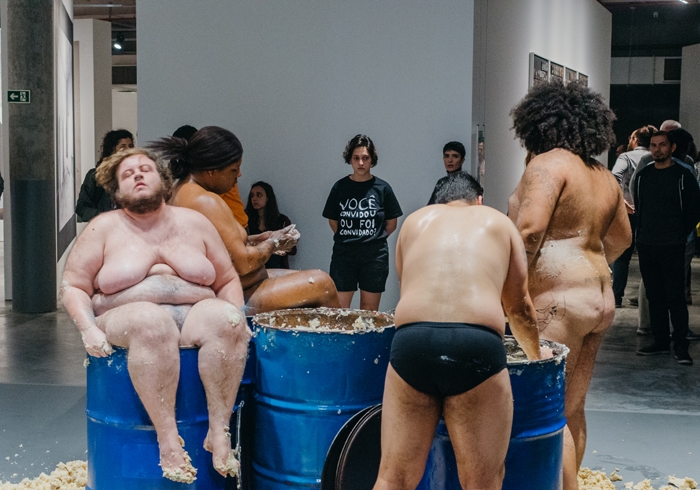SESC
Sorocaba and other venues, 12
August – 3 December
While
the biennials in São Paulo, Salvador da Bahia, Curitiba and Porto Alegre (inaugurated
in 1951, 1966, 1996 and 1993, respectively) have been on the circuit for some
years now, Sorocaba is hosting the Frestas Triennial for only the second time.
An initiative of the non-profit SESC (thriving on a 1.5% payroll tax on
commerce workers), this year’s edition has been curated by Daniela Labra under
the title Between post-Truth and Events and features the work of 60
artists. Now a conservative industrial town, Sorocaba had been populated by
indigenous Guarani populations until Baltasar Fernandes and the Bandeirantes ‘discoverers’ conquered the land in 1654 and enslaved its inhabitants. This narrative of the
city’s ‘founding’ history is told on plaques that seem to have been semi-permanently
attached to the monastery and historical museum as well as through public
monuments dedicated to the colonisers around town.
Two female
Guarani activists, Poty Poran and Eunice Martims, who had been invited to give
a public talk by artist Maria Thereza Alves on the triennial’s opening day, narrated
the other side of the story, describing the families’ ejection from their lands
and the hostile reality of Guarani life in today’s São Paulo state.
Afterwards, the audience were led to see a number of traditional Guarani
ceramic urns, produced by Alves in collaboration with Maximino Rodrigues, and placed
in different locations around the city with the intent of re-inscribing Guarani
history in the local imaginary. Alves’s subtle disturbances of the public space
are boldly underpinned by Nunca’s mural Fundadores (Founders, 2017)
on Praça Coronel Prestes, depicting three Guarani with traditional facepaint watching
over the city. Below them the words: Body, Memory, Land, History, Culture, Tradition,
Language, Origin and Roots are painted in Portuguese and function as
a reminder of the now disenfranchised ancestors.
Inside the main venue the smell of fat
permeates the gallery. Miro Spinelli’s performance installation Gordura
Trans (2017) features the artist and three other naked performers kneeling
and resting between barrels of lard as well as occasionally sculpting the
grease onto their bodies and surrounding walls. Asserting their own non-binary
gender, the artist’s work provokes discussion on essentialist discourse and fat-phobism
reigning not only in the Brazilian province but also in the artworld. The Guerrilla Girls present a
selection of four banners from their last 30 years of production, including Do
Women have to be naked to get into the Met. Museum? (1989-2017) and Dear
Billionaire Collector (2015). Although the issues raised in the banners are
pertinent here, they seem to lack traction with exhibition visitors. The Guerrilla
Girls Complaints Department (2017) blackboard on the other hand quickly fills
up with visitor sentiments ranging from ecological to political demands (‘More
Trees’ and ‘Stop homophobia in Sorocaba’). O Nome do Boi protests the 2015 government
takeover and the notorious kleptocrats currently reigning over corruption-ridden
Brazil: the collective takes its name from a Brazilian saying which
roughly translates as ‘by naming the ox one points out those responsible’. Mug
shots of those implicated in the recent corruption scandal engulfing the
conglomerate Odebrecht are wallpapered alongside codenames and placed adjacent
to the mirrored logos of companies and agencies supporting the men in power. A
of lump of beef, its packing bearing the logo of Friboi, a meat company accused
of bribing government inspectors, rots in a nearby glass vitrine.
large-scale exhibitions such as this one prove an important apparatus to carry non-normative narratives into the more remote region
While
their work functions as an audacious and straightforward disclosure act, André
Komatsu develops the discourse with an analogy between abstract geometric
traditions and socio-political perspectives. Placed just outside the city’s bus
terminal, Komatsu’s Autômatos (2017), an architectural installation that
juxtaposes building materials such as mirrors, semi-transparent Plexiglas and plasterboard,
toys with ideas of transparency, permeability and enclosure that can be
considered a paradigm for the exhibition’s title. These subjects concerning
post-colonialism might not be new – institutions in São Paulo (and other
artworld capitals) have long engaged in a critical discourse around such
legacies – but large-scale exhibitions such as this one prove an important
apparatus to carry non-normative narratives into the more remote regions.
From the October 2017 issue of ArtReview
